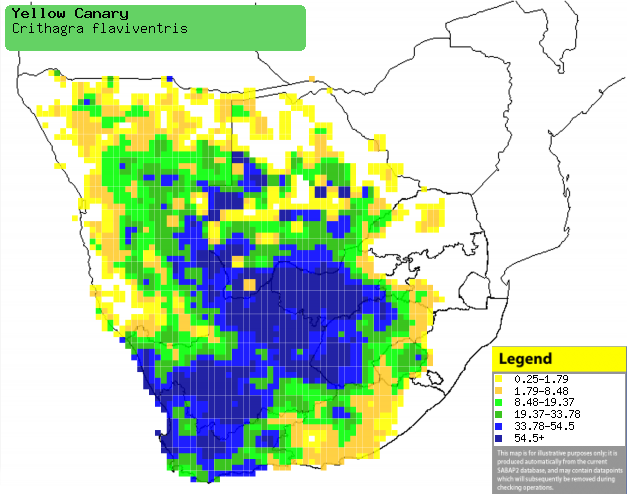|
Crithagra flaviventris (Yellow
canary)
[= Serinus flaviventris]
Geelkanarie [Afrikaans]; Nsense, Kandingo (generic terms for
canaries) [Kwangali]; Toere (generic term for canaries and siskins) [South
Sotho]; Geelbuiksijs, Geelbuikkanarie [Dutch]; Serin de Sainte-Hélène
[French]; Gelbbauchgirlitz [German]; Canário-de-barriga-amarela [Portuguese]
Life
> Eukaryotes >
Opisthokonta
> Metazoa (animals) >
Bilateria >
Deuterostomia > Chordata >
Craniata > Vertebrata (vertebrates) > Gnathostomata (jawed
vertebrates) > Teleostomi (teleost fish) > Osteichthyes (bony fish) > Class:
Sarcopterygii (lobe-finned
fish) > Stegocephalia (terrestrial
vertebrates) > Tetrapoda
(four-legged vertebrates) > Reptiliomorpha > Amniota >
Reptilia (reptiles) >
Romeriida > Diapsida > Archosauromorpha > Archosauria >
Dinosauria
(dinosaurs) > Saurischia > Theropoda (bipedal predatory dinosaurs) >
Coelurosauria > Maniraptora > Aves
(birds) >
Order: Passeriformes > Family: Fringillidae
Distribution and habitat
Near-endemic to southern Africa, occurring from
south-western Angola through Namibia and Botswana to much of South Africa,
largely excluding the provinces in the east. It generally prefers open Karoo
shrubland (especially along drainage lines), alpine shrubland, semi-arid savanna,
arid fynbos, dune vegetation, strandveld, weedy road verges and gardens.
|
 |
|
Distribution of Yellow canary in southern Africa,
based on statistical smoothing of the records from first SA Bird Atlas
Project (©
Animal Demography unit, University of
Cape Town; smoothing by Birgit Erni and Francesca Little). Colours range
from dark blue (most common) through to yellow (least common).
See here for the latest distribution
from the SABAP2. |
Predators and parasites
It has been recorded as prey of
Falco peregrinus
(Peregrine falcon) and its eggs are eaten by
Dasypeltis scabra (Common eggeater).
Movements and migrations
Resident and nomadic, sometimes migrating out
of its usual distribution in drought years.
Food
It mainly eats seeds supplemented with nectar, flower,
insects and small crustaceans, doing most of its foraging on the ground. The following food items have been recorded
in its diet:
- Plants
- seeds
- grasses
- Brachiara glomerata (signal grass)
- Eleusine coracana (goose grass)
- forbs and shrubs
- Arctotheca calendula (African calendula)
- Atriplex lindleyi (Blasiebrak)
- Bidens pilosa (Common blackjack)
- Salsola kali (Russian tumbleweed)
- Cannomois (Restionaceae)
- Chenopodium (misbredies)
- Cliffortia
- Diascia
- Dorotheanthus (carpet-weeds)
- Dicerothamnus rhinocerotis (Renosterbos)
- Erica
- Eriocephalus (Karoo rosemaries)
- Gazania
- Gnidia
- Melianthus (honey-flowers)
- Osteospermum (daisies)
- Rumex (docks)
- Salvia
- Senecio (groundsels)
- Stoebe (zig-zag bushes)
- Mesembryanthemaceae
- fruits
- Lycium (honey-thorns)
- Aloe barberae (Eastern tree aloe)
- Invertebrates
- insects
-
termites
- Trinervitermes (snouted harvester termites)
- Hodotermes mossambicus (Northern harvester termite)
- beetle larvae (Coleoptera)
- fly larvae (Diptera)
- ants
- beach hoppers (Talorchestia)
Breeding
- Monogamous, territorial solitary nester, with nests spaced few and far
between.
- The nest is built solely by the female in about 3-4 days, consisting of
a cup of dry plant stems, rootlets, soft weeds, tendrils, rootlets and
strips of Lammerlat (Gomphocarpus filiformis) bark. The interior is
lined with softer material, such as the fluffy seeds of Karoo rosemaries (Eriocephalus)
or milkweeds (Asclepias), wool and sometimes a few feathers. It is
typically placed in a shrub, such as Scholtzbos (Pteronia pallens)
and Gombossie (Pteronia viscosa), honey-thorn (Lycium) or a
small tree.
- Egg-laying season is almost year-round in arid areas, peaking from
July-October in the Western Cape and from August-April elsewhere.
- It lays 2-5 eggs, which are incubated solely by the female for about
12-16 days.
- The chicks are fed both parents, leaving the nest after about 16 days.
Threats
Not threatened.
References
-
Hockey PAR, Dean WRJ and Ryan PG 2005. Roberts
- Birds of southern Africa, VIIth ed. The Trustees of the John Voelcker
Bird Book Fund, Cape Town.
|
